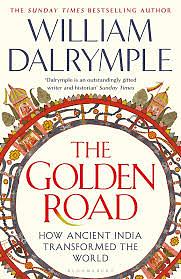You need to sign in or sign up before continuing.
Take a photo of a barcode or cover
informative
inspiring
fast-paced
informative
reflective
slow-paced
This is a must read for all culture, mythology and history afficionados!
Dalrymple smoothly disks readers away on an odyssey across ancient India, Afghanistan to Agra, Cambodia to China.
Focusing on walking the middle road between Indian supremacy and subordination, Dalrymple zeroes in on the marvellous influence of India across the academic realm through the lens of science, religion, and economics.
Be astounded at the rich mythology as Dalrymple weaves the Indian tales of yore, expertly exported across the whole of south east asia. Marvel at the Indian advances in mathematics and science that paved the way for the modern world today.
An scholarly approach as told by a tenderly grandgather, Dalrymple makes this easily accessible to anyone interested in this era, regardless of academic ability.
Whilst the ending felt rushed and constrained, I still delighted in the many wonderful tales being told.
Wholeheartedly reccomend without a shadow of a doubt!
Dalrymple smoothly disks readers away on an odyssey across ancient India, Afghanistan to Agra, Cambodia to China.
Focusing on walking the middle road between Indian supremacy and subordination, Dalrymple zeroes in on the marvellous influence of India across the academic realm through the lens of science, religion, and economics.
Be astounded at the rich mythology as Dalrymple weaves the Indian tales of yore, expertly exported across the whole of south east asia. Marvel at the Indian advances in mathematics and science that paved the way for the modern world today.
An scholarly approach as told by a tenderly grandgather, Dalrymple makes this easily accessible to anyone interested in this era, regardless of academic ability.
Whilst the ending felt rushed and constrained, I still delighted in the many wonderful tales being told.
Wholeheartedly reccomend without a shadow of a doubt!
adventurous
challenging
informative
inspiring
reflective
medium-paced
The Golden Road intrigued me, as after reading The Silk Roads by Peter Frankopan I was intrigued to learn more about how ideas beginning in one area can be translated to a wider area. I hve always been fascinated by India and South Asian history, so this seemed like the perfect jumping off point. After completing the book, I will say I wanted a bit more explanation of the history of how or why ideas spread, but this book offers many different rabbit holes to explore. This genuinely offers readers a glimpse on how ideas from India were spread and where archeological evidence has been found throughout history of it. Awesome book for those interested to learn a bit more about Buddhism's spread in China and Southeast Asia, as well as India's numerical system and many other Indian exports.
adventurous
challenging
informative
medium-paced
Informative and great to see how much Indian culture influenced the world.
Interesting but disappointing ... not really hoelw India transformed the world more how it indirectly influenced it through trade Buddhism and numbers
challenging
informative
slow-paced
This book is fairly accessible for readers coming into the topic with a limited knowledge of ancient India. The author does a great job of blending anecdotes with information, and I learned a lot about India's influence on the ancient (and even modern) world. Will definitely be reading more on this topic in the future!
The notes are better reading than the main text, in fact they are more pages of notes!
Dalrymple sets out to illustrate how India exercised soft (and not so soft) power for a millenia-and-a-half - spreading its culture from Vietnam to Greece.
I liked the first 2 parts of this 3 part book. Part 1 covering the period before and slightly after the Common Era. It can broadly be said to cover the period when Buddhism emerged from India and spread Westwards and Northwards. This part ends around Tang Dynasty China. Part 2 covers the period around the first millenium and focuses on the spread of Hindu influence in SE Asia (Cham, Khmer, Thai, Srivijaya, ...). Part 3 covers the medieval period and focuses on the spread of Indian ideas of mathematics Westward through the Abbasid Caliphate and Cordoba.
I liked Parts 1 and 2. Part 3 was a little bit of a stretch. I find the connection that Dalrymple tries to underline of Indian culture and influence spreading through the Barmakhids a little tenuous,
I liked the first 2 parts of this 3 part book. Part 1 covering the period before and slightly after the Common Era. It can broadly be said to cover the period when Buddhism emerged from India and spread Westwards and Northwards. This part ends around Tang Dynasty China. Part 2 covers the period around the first millenium and focuses on the spread of Hindu influence in SE Asia (Cham, Khmer, Thai, Srivijaya, ...). Part 3 covers the medieval period and focuses on the spread of Indian ideas of mathematics Westward through the Abbasid Caliphate and Cordoba.
I liked Parts 1 and 2. Part 3 was a little bit of a stretch. I find the connection that Dalrymple tries to underline of Indian culture and influence spreading through the Barmakhids a little tenuous,
informative
The Golden Road, William Dalrymple
Dalrymple’s newest book presents a compelling thesis. That from several centuries BC until at least the 12th century, the main communication between Asia and the West was via the maritime trade routes established by India. He marshals a huge amount of scattered evidence and information to support this revolutionary idea. The book itself, while substantial, is 30% notes and references, which underlines the thoroughness of his historical research and strengthens his argument. He shows convincingly that India was Rome’s most important trading partner-for spices, luxury goods, silk etc, accounting for as much as 30% of the Empire's customs revenue! As such it financed much of the Empire's infrastructure. India did this without conquest or war, but by the export of ideas and goods through trade. Dalrymple casts doubt on the idea of the Silk Road, which he shows is the fantasy of a late 19th century German historian, with little evidence for its actual existence during the period covered by this book.
India not only exported goods, but also ideas. The first was Buddhism, and with such success that the largest religious monument in the world-Angkor Wat, dwarfs the Vatican fourfold. It was refreshing to read about T’ang Dynasty Empress Wu Zetian, who made Buddhism one of China’s three state religions in the 7th century. In fact, as I look at so-called historical pages on social media I am appalled by how phallocentric they are. Roman Empire pages for example, contain nothing but praise of war, gladiators, etc. Run by guys, these pages just post guy-stuff. There’s nothing there to interest women or anyone else, though undoubtedly there was at the time and still is. Dalrymple’s book was so refreshing by contrast! It presents history through the lens of trade and ideas, not just war and conquest.
The final 3 chapters cover the invention of the numerical and calculation systems we use today. They, with the concept of zero and its use as a number, which underlies them, were developed in India, though they are called “Arabic numerals” since they were exported first to the Arab world and thence to Europe. They enabled complex mathematics and are in effect a universal language. This system was finally introduced in a practical form in Italy by the mathematician Fibonacci, with the sponsorship of the Holy Roman Emperor Frederick II of Hohenstaufen, aka the “Stupor Mundi” (The Wonder of the World), a title which he richly deserved and one of my favorite characters in history! There are many detailed reviews online. I can only say that as an Indian, it was really refreshing to finally see the great civilization of India given its due. I recommend The Golden Road highly-the book’s thesis will result in much discussion and an overhaul of the way we view this ancient world.




